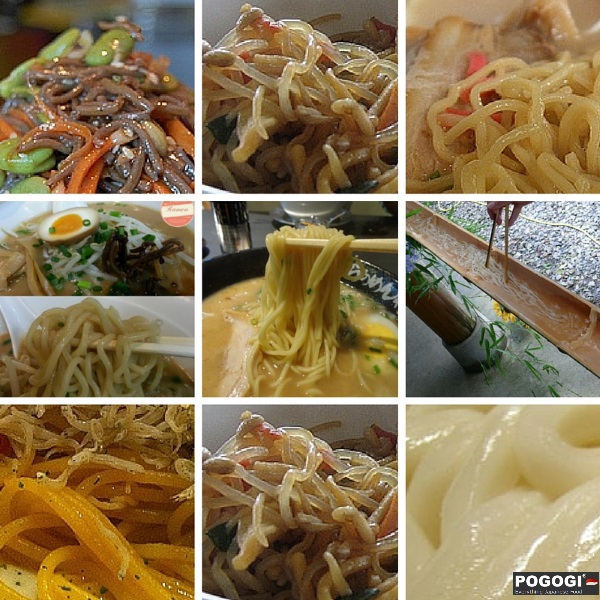Exploring The World Of Japanese Noodles: A Culinary Journey Through Ramen, Udon, And Soba
Apr 21 2025
Japanese noodles, commonly referred to as "noodles japones," have captivated the hearts and stomachs of food enthusiasts worldwide. From the rich and savory ramen to the delicate and earthy soba, these noodles offer a diverse culinary experience that reflects Japan's deep-rooted food culture. As global interest in Japanese cuisine continues to grow, understanding the intricacies of noodles japones can enhance your appreciation for this beloved food group. In this article, we will delve into the history, preparation, and cultural significance of Japanese noodles, providing insights that cater to both beginners and seasoned food lovers alike.
With their unique textures and flavors, noodles japones have become a staple in many households and restaurants around the world. Whether served hot or cold, in broth or as a standalone dish, these noodles offer versatility that appeals to a wide range of palates. As you explore the world of Japanese noodles, you'll discover the artistry and craftsmanship that goes into creating each type, from the chewy texture of udon to the nutty flavor of soba.
This article aims to provide a comprehensive guide to noodles japones, covering everything from their origins to modern-day interpretations. By the end of this piece, you'll have a deeper understanding of why these noodles hold such an important place in Japanese cuisine and how they continue to influence global food trends. So, let's embark on this delicious journey through the world of noodles japones!
Read also:Bryan Stevenson Wife A Comprehensive Look Into Her Life And Their Journey
What Are the Different Types of Noodles Japones?
When it comes to noodles japones, there are several varieties to explore. Ramen, udon, and soba are the most popular types, each with its own distinct characteristics. Ramen, for instance, is known for its wheat-based noodles served in a flavorful broth, often accompanied by toppings such as pork, nori, and scallions. Udon, on the other hand, consists of thick, chewy noodles that are typically served in a hot broth or as a chilled dish with dipping sauce. Soba, made from buckwheat, offers a unique nutty flavor and can be enjoyed either hot or cold, depending on the season.
How Are Noodles Japones Made?
The preparation of noodles japones involves a combination of traditional techniques and modern innovations. For ramen, the process begins with kneading dough made from wheat flour, water, and kansui, a type of alkaline water that gives the noodles their distinctive texture. Once the dough is ready, it is rolled out and cut into thin strands before being cooked. Udon noodles require a similar process but use a different ratio of ingredients to achieve their thicker consistency. Soba noodles, meanwhile, incorporate buckwheat flour, which adds both flavor and nutritional value to the final product.
Why Are Noodles Japones So Popular?
The popularity of noodles japones can be attributed to several factors. Firstly, their versatility allows them to be adapted into countless dishes, catering to various tastes and preferences. Additionally, the nutritional benefits of certain types, such as soba, make them an attractive option for health-conscious consumers. Moreover, the cultural significance of noodles japones in Japan has helped to elevate their status on the global stage, drawing attention from food enthusiasts eager to learn more about this fascinating cuisine.
What Is the History Behind Noodles Japones?
The history of noodles japones dates back centuries, with each type having its own unique story. Ramen, for example, is believed to have originated in China before being introduced to Japan in the late 19th century. Over time, Japanese chefs adapted the recipe to suit local tastes, resulting in the ramen we know and love today. Udon, on the other hand, has been a part of Japanese cuisine for over a thousand years, with its origins traced back to the Nara period. Soba, made from buckwheat, became popular during the Edo period as a quick and easy meal for busy city dwellers.
Can Noodles Japones Be Customized?
Absolutely! One of the joys of noodles japones is the ability to customize your dish to suit your preferences. With ramen, you can choose from a variety of broths, such as shoyu (soy sauce), miso, or tonkotsu (pork bone), and add toppings like soft-boiled eggs, bamboo shoots, or corn. Udon noodles can be enjoyed in a range of dishes, from simple hot soups to elaborate stir-fries. Soba noodles offer similar flexibility, with options to serve them hot or cold, plain or with additional ingredients like tempura bits or mountain vegetables.
Where Can I Find Authentic Noodles Japones?
Authentic noodles japones can be found in specialized restaurants, often referred to as "noodle shops" or "ramen-ya." These establishments focus on serving high-quality, traditional dishes that showcase the best aspects of Japanese noodle cuisine. Additionally, many grocery stores now stock imported Japanese noodles, allowing you to recreate these dishes at home. For those looking to experience the full range of flavors and textures, visiting Japan and exploring its regional noodle specialties is highly recommended.
Read also:Daniel Tutt A Comprehensive Exploration Of His Life Achievements And Influence
Which Noodles Japones Are Best for Beginners?
For beginners, starting with ramen is often the best choice, as it offers a well-rounded taste experience that combines rich broth with chewy noodles. If you're looking for something lighter, soba noodles served cold with dipping sauce provide a refreshing option that highlights the unique flavor of buckwheat. Udon noodles, with their neutral taste and satisfying texture, are another great entry point into the world of noodles japones.
What Are the Health Benefits of Noodles Japones?
Beyond their delicious taste, noodles japones also offer several health benefits. Soba noodles, in particular, are praised for their high fiber content and ability to support heart health. Buckwheat, the main ingredient in soba, is also gluten-free, making it an excellent choice for those with dietary restrictions. Udon noodles, when paired with a light broth, can provide a filling yet low-fat meal. Even ramen, often criticized for its sodium content, can be made healthier by using homemade broth and adding plenty of vegetables.
How Can I Cook Noodles Japones at Home?
Cooking noodles japones at home is easier than you might think. For ramen, start by preparing your broth using ingredients like chicken or pork bones, kombu, and ginger. Once the broth is ready, cook your noodles according to package instructions and assemble your dish with your preferred toppings. Udon noodles can be quickly boiled and served in a simple dashi broth, while soba noodles require a slightly shorter cooking time and can be enjoyed with a dipping sauce made from soy sauce, mirin, and dashi.
What Are Some Creative Ways to Use Noodles Japones?
While traditional recipes for noodles japones are always a safe bet, there are plenty of creative ways to incorporate these ingredients into your cooking. For instance, you can use ramen noodles as a base for a stir-fry or add them to a creamy carbonara-style pasta dish. Udon noodles can be transformed into a hearty curry or even used in a salad with a peanut dressing. Soba noodles pair well with summer fruits in a chilled dessert or can be baked into a savory tart.
Where Do Noodles Japones Fit Into Modern Cuisine?
Noodles japones have seamlessly integrated into modern cuisine, inspiring chefs around the world to experiment with new flavors and techniques. Fusion dishes that combine Japanese noodles with international ingredients have become increasingly popular, showcasing the adaptability of these versatile ingredients. As food trends continue to evolve, noodles japones remain at the forefront, proving that their appeal transcends cultural boundaries.
Conclusion: Embracing the Flavorful World of Noodles Japones
From their humble beginnings to their current status as global culinary stars, noodles japones have much to offer both in terms of taste and cultural significance. By exploring the various types, preparation methods, and health benefits associated with these noodles, you can deepen your appreciation for this essential component of Japanese cuisine. Whether you're dining at a high-end restaurant or whipping up a quick meal at home, noodles japones promise to deliver a satisfying and memorable experience every time.
Table of Contents
- What Are the Different Types of Noodles Japones?
- How Are Noodles Japones Made?
- Why Are Noodles Japones So Popular?
- What Is the History Behind Noodles Japones?
- Can Noodles Japones Be Customized?
- Where Can I Find Authentic Noodles Japones?
- Which Noodles Japones Are Best for Beginners?
- What Are the Health Benefits of Noodles Japones?
- How Can I Cook Noodles Japones at Home?
- What Are Some Creative Ways to Use Noodles Japones?


